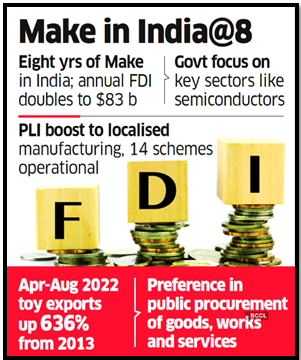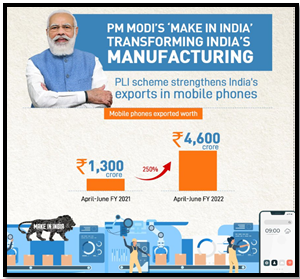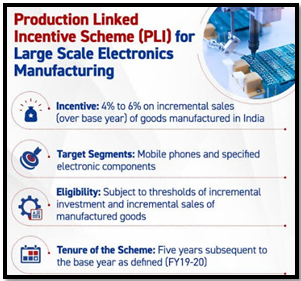A MISSING INDUSTRIAL POLICY
Syllabus
- GS3: Indian Economy and issues relating to Planning, Mobilization of Resources, Growth, Development and Employment.
Why in the News?
- The Make in India (MII) campaign, initiated in 2014, represents a departure from past self-sufficiency approaches.
- While concerns exist about protectionist measures, assessing MII’s impact on job creation, especially in labor-intensive sectors, remains challenging due to limited official data.
Source: Mint
Make in India: A Departure from Past Policies
Make in India (MII)
- The Make in India campaign, initiated in 2014, marks a significant departure from India’s historical self-sufficiency dogma of the 1970s.
- Unlike the earlier era of dirigisme, license raj, and import-substituting industrialization, Make in India embraces a different approach.
Notable Differences
- Make in India is distinctively dissimilar, steering away from the restrictive policies associated with self-sufficiency and emphasizing a more open and globalized economic
Implementation Challenges
- Despite its innovative approach, concerns have been raised about the implementation of Make in India, particularly in sectors where tariff duties are increased for domestic industry protection.
Protectionist Fears: A Look Back and Ahead
Exaggerated Concerns
- Worries about protectionist tendencies in Make in India (MII) extending to various sectors might be overstated but not without reason, particularly for those who witnessed the challenges of the 1970s and 1980s.
Past Pitfalls
- Recollections of reckless protectionism during those years led to shortages, black markets, and widespread rent-seeking, all under the guise of serving the poor and achieving distributive justice.
Lessons from History
- The licensing of cars, scooters, telephones, and other sectors created imbalances, benefitting producers rather than the intended consumers, who had no recourse.
- Producers, enjoying protection, lobbied for the perpetuation of such regimes.
Modern Realities
- Applying the same protectionist approach to components for mobile phone assembly in today’s scenario would likely lead to industry chaos, given the significant reliance on imported content (around 80-85%).
- Make in India stands apart from the outdated concept of self-sufficiency, emphasizing the need to move beyond unwarranted comparisons.
Make in India: Delivering on Promises?
Assessing Make in India
- As we scrutinize the Make in India initiative, essential questions arise regarding its public presentation and actual outcomes.
- How has it been portrayed to the public, and has it fulfilled its promises?
Core Policy – Make in India
- While MII has derivatives like Made in India and Make for India, we consider MII as the foundational and primary policy.
- The others, such as Make for India, focusing on domestic production, and Made in India, a branding strategy, are seen as secondary aspects.
Export Competitiveness is Key
- MII aims at export competitiveness, highlighting that having a robust home market isn’t a substitute for excelling in exports.
- Successful nations like Japan, Korea, and China achieved economic takeoff through export competitiveness.
Made in India Branding
- The Made in India concept is a branding strategy promoting products born out of Indian resources, emphasizing land, labor, capital, and technology.
- However, its success hinges on the effectiveness of MII operations.
Source: Mygov
Learning from China’s Experience
- Reflecting on China’s journey, overcoming the stigma associated with “Made in China” took considerable time.
- MII aims to avoid a similar label in foreign markets, prioritizing a positive global perception.
Making in India: Past Efforts and Current Reflections
Inception of Make in India
- Make in India aimed at fortifying the manufacturing sector’s competitiveness.
- The National Manufacturing Policy (NMP) of 2011 highlighted challenges like inadequate infrastructure, a complex regulatory environment, and a shortage of skilled manpower, hindering sector growth.
- Its goal was to boost the manufacturing contribution to GDP from 15% to 25% and generate 100 million jobs, but success remained elusive.
Dynamic Objectives of MII 2014
- MII not only embraced the ambitious goals of NMP 2011 but also aspired to position India as a global design and manufacturing export hub.
- In simpler terms, it aimed to make things in India not just for the nation but for the entire world.
Pause on New Industrial Policy (NIP ’23)
- Recently, the government delayed the implementation of the new industrial policy (NIP ’23), under development for over two years.
- With the ongoing production-linked incentive (PLI) scheme, the question arises: What additional benefits can the industrial policy offer at this stage of India’s economic journey?
Power of PLI Schemes
- The Production-Linked Incentive (PLI) schemes aim to attract investments in crucial sectors and cutting-edge technologies.
- Their mission includes enhancing efficiency, achieving economies of scale, and fostering global competitiveness among Indian companies and manufacturers.
Beyond PLI: Necessity of Industrial Policy
Source: Mygov
- While PLI schemes address specific sectors, there’s a call for a broader industrial policy, especially for labor-abundant countries like India with modest educational achievements.
- The primary focus should be on creating productive jobs, particularly for women, through labor-intensive manufacturing.
- This aligns with the idea that abundant factors, like skilled labor, play a pivotal role in competitiveness and scalability.
Key Focus: Job Creation
- The central objective of the industrial policy should be to generate quality jobs with social protection, countering the narrative of jobless growth.
- For India, success in industrial policy should be measured by its ability to create mass employment, placing it as the cornerstone of accomplishment.
Challenges in Indian Labor Market
- India’s labor market grapples with low-paying, low-productivity, and largely informal jobs, especially in the unorganised sector.
- More than 99% of the country’s 63 million Micro, Small, and Medium Enterprises (MSMEs) operate in this unorganised realm, lacking the flexibility for substantial job creation.
MII’s Impact on Job Landscape
- Assessing Make in India’s impact on job creation, particularly in light of China’s manufacturing scale, is a critical yet complex task.
- Unfortunately, the lack of frequent and timely official data makes scrutinizing MII’s performance challenging.
- Understanding its influence on jobs and scalability remains a weighty concern for India’s economic trajectory.
Policy Making Challenges
- In the absence of comprehensive data, policymaking becomes akin to throwing darts blindfolded.
- As economist Kaushik Basu rightly noted, effective economic policymaking requires both intellect (to interpret data) and a moral compass for societal betterment.
- Given the limited data on the Production-Linked Incentive (PLI) scheme’s impact, especially in terms of value addition and job creation, a strong reliance on the moral compass is crucial.
- The upcoming release of the New Industrial Policy (NIP) should continue emphasizing India’s strength in labor-intensive sectors for widespread benefit, despite the focus on high-end manufacturing through PLI.
| National Manufacturing Policy (NMP) 2011
· The NMP 2011, a strategic initiative by the Government of India, aimed to elevate the manufacturing sector’s contribution to GDP from 16% to 25% in a decade, concurrently generating 100 million jobs. · The overarching vision was to position India as a global manufacturing powerhouse, fostering economic prosperity. Key Objectives · Industrial Infrastructure Enhancement: Development of state-of-the-art industrial infrastructure, featuring Special Economic Zones (SEZs) and National Investment and Manufacturing Zones (NIMZs). · Business Environment Overhaul: Streamlining regulations, simplifying procedures, and mitigating bureaucratic impediments to attract robust investments. · Technological Upgradation Drive: Promotion of research and development, embracing advanced technologies, with a special emphasis on fostering green manufacturing practices. · Skill Development Focus: Creation of a skilled workforce through targeted vocational training and skill development programs aligned with the evolving needs of the industry. · MSME Sector Empowerment: Strengthening Micro, Small and Medium Enterprises (MSMEs) through a comprehensive support framework encompassing financial incentives, technology transfer, and initiatives for enhanced market access. |
Source
https://indianexpress.com/article/opinion/editorials/a-test-for-women-9083916/
Mains Practice Question
Examine the contrast between Make in India and the earlier policy of self-sufficiency adopted in the 1970s. Discuss concerns related to the potential spread of protectionist tendencies and their historical implications.

 Source: Mint
Source: Mint Source: Mygov
Source: Mygov Source: Mygov
Source: Mygov

